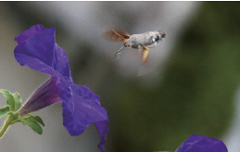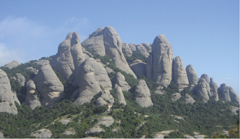
Campus Moncloa
Campus of International Excellence
Paleogene
66-23 M.a.


Sphinx Butterfly pollinating a Petunia flower (Angiosperma)

Montserrat Conglomerate (Spain)./span>
The separation of the continents continues and leads them to their current position. Europe and Africa separate from the two Americas, India speeds towards Asia and Antarctica stands alone over the South Pole. This distribution of the continental masses creates the Antarctic Circumpolar Current, causing climatic cooling and the formation of the southern polar cap. The northward movement of Africa and India and their collision with Europe and Asia lead to the Alpine orogeny and the building of the mountain ranges in southern Europe (the Alps, Carpathians, Pyrenees, Baetic range) and the Himalayas. The subduction of the Pacific Ocean floor continues with the creation of the Rockies and the Andes. After the Cretaceous extinction and the disappearance of large reptiles, the evolutionary spread of mammals, flowering plants and pollinating insects will colonise virtually all habitats.

Basilosaurus (Mammal, Cetacea).
| Hadean | ~4600-4000 M.a. |
| Archean | 4000-2500 M.a. |
| Proterozoic | 2500-541 M.a. |
| Cambrian | 541-485 M.a. |
| Ordovician | 485-443 M.a. |
| Silurian | 443-419 M.a. |
| Devonian | 419-359 M.a. |
| Carboniferous | 359-299 M.a. |
| Permian | 299-252 M.a. |
| Triassic | 252-201 M.a. |
| Jurassic | 201-145 M.a. |
| Cretaceous | 145-66 M.a. |
| Paleogene | 66-23 M.a. |
| Neogene | 23-2,6 M.a. |
| Quaternary | 2,6 M.a.-act. |
